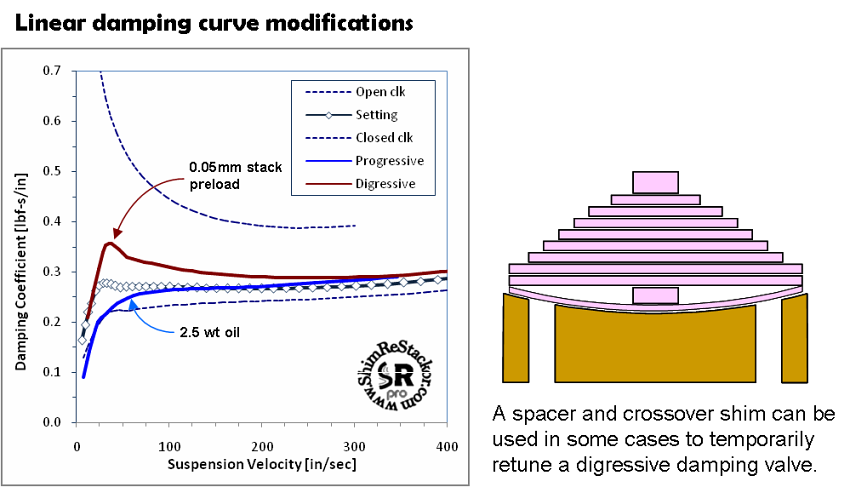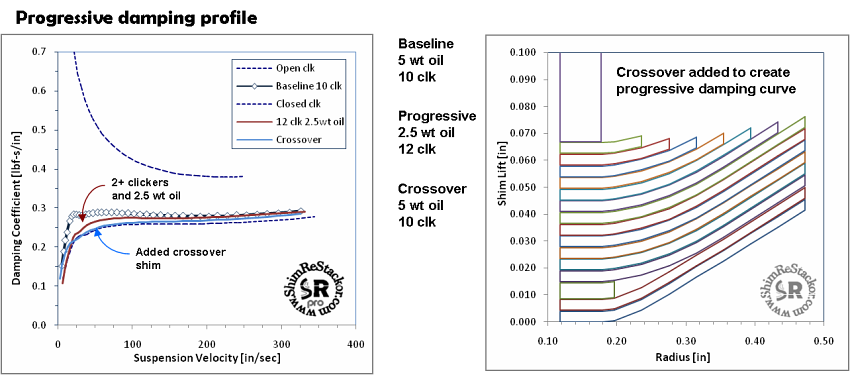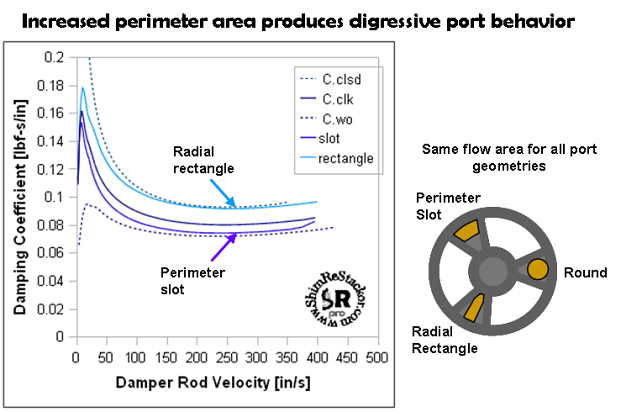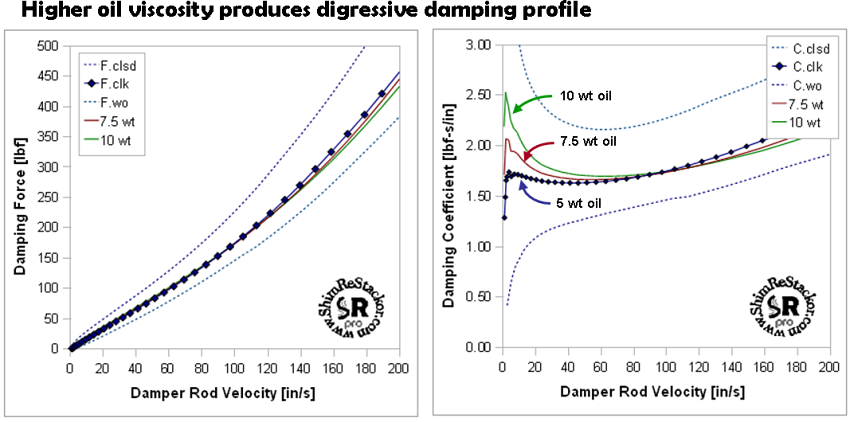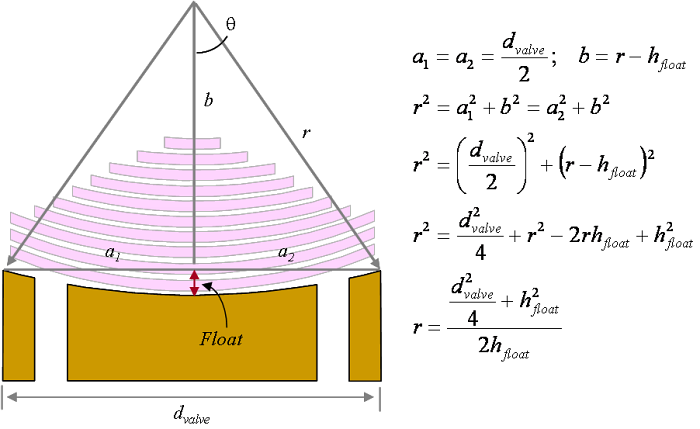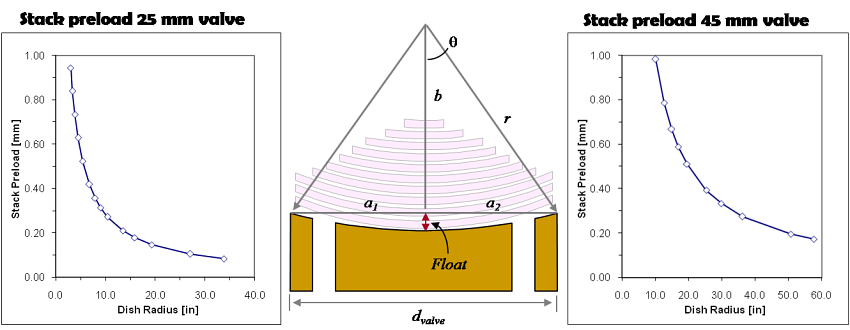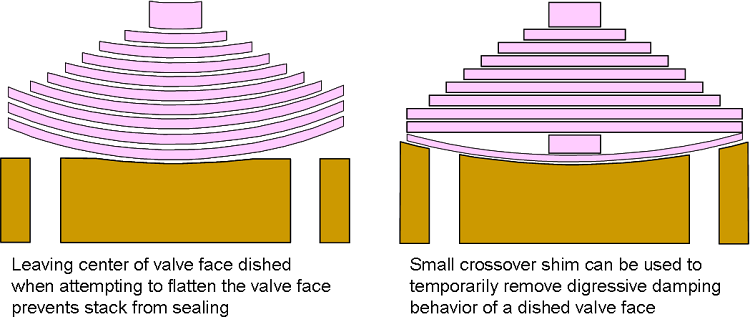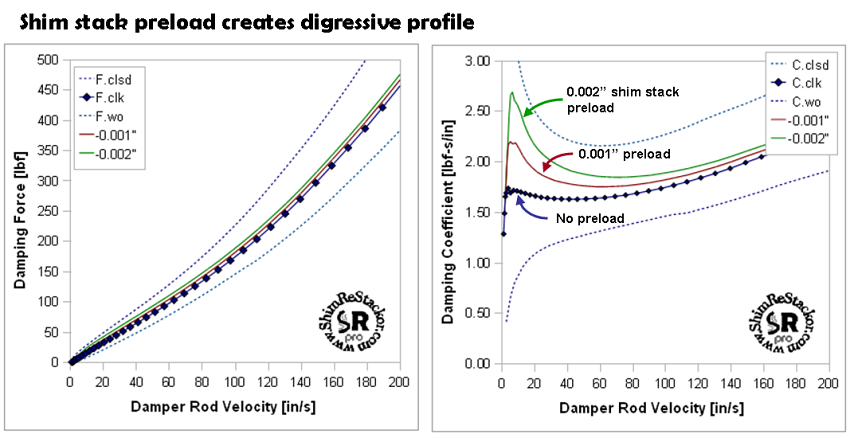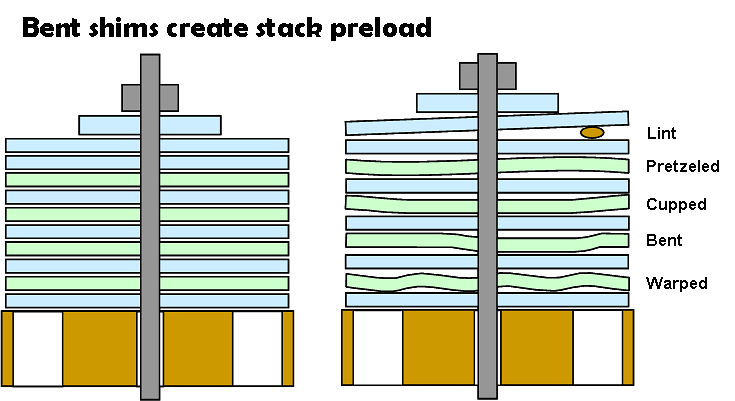

Tuning Basics
Sample Applications

ReStackor Sample Applications
Finally computer software to tune a shim stack
Damper Profile Shape Tuning
Shock absorbers produce three fundamental shapes of damping curves: digressive; progressive and linear. Suspension features produced by each damping profile are discussed below as well as shock absorber tuning modifications needed to establish each type of profile.
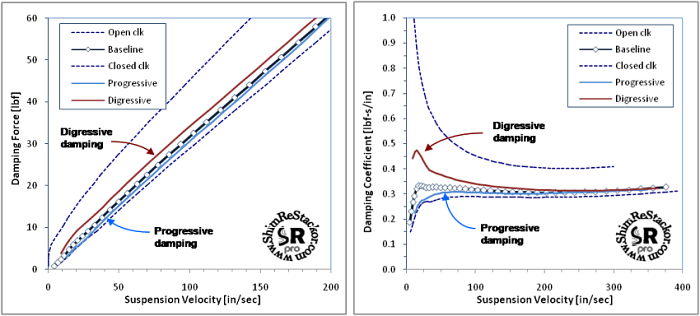
ReStackor pro gives you the capability to tune the shape of shock absorber damping profile to create linear, progressive or digressive damping profiles.
Linear Damping Profile
Linear damping produces a linear increase in damping force with increasing suspension velocity and maintains a constant relationship between the momentum of the moving un-sprung mass of the suspension and the damping forces produced.
Fundamentally you expect damping forces produced by the suspension to be linear. When you hit a bump that is twice as big you expect the impact to be twice as large. When this doesn’t happen riders describe the suspension as blowing through its stroke (digressive damping profile) or the suspension suddenly becoming stiff on large hits (progressive damping profile). Linear damping is typically a good place to begin tuning of a new suspension setup. After several rides on that setup if the suspension has a tenancy to tuck on corner entrances or deflect off impacts you can begin refining the shape of the damping profile to correct for those problems.
![]()
Linear damping profile
-
Features: Maintains a constant relationship between damping force and momentum of the sprung and un-sprung suspension components across the entire range of suspension speeds. This gives the suspension a consistent feel through the entire stroke. Starting from a linear damping curve if the suspension has a tendency to tuck on corner entrances you can run the clickers a couple of clicks in to produce a digressive damping profile and correct that behavior. Conversely if the suspension is too stiff at low speed and deflects off of rocks you can run the clickers a couple of clicks out to produce a progressive damping profile. The capability to drive a linear damping curve toward a progressive or digressive curve shape through a simple change in clicker settings is a useful feature and can be used to adapt the suspension to changing riding conditions.
-
Drawbacks: Oil viscosity changes and clicker settings can drive a linear damping curve toward a progressive or digressive curve but neither of those curves can be fully achieved without retuning of the valve and shim stack.
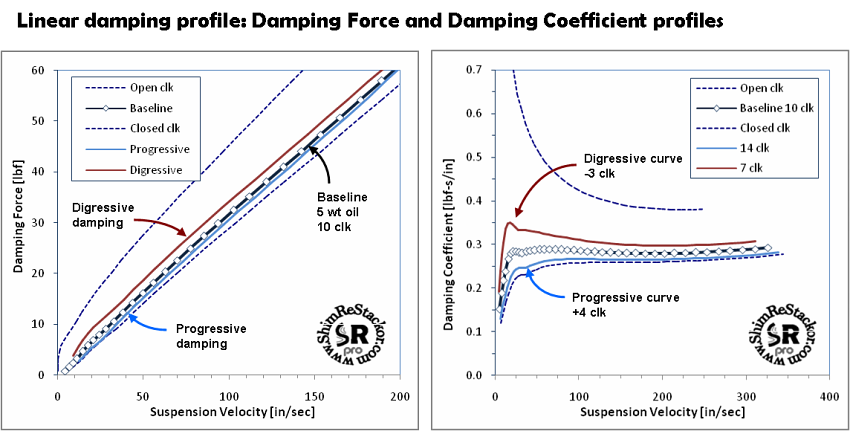
When starting with a linear damping rate the damping profile can be driven toward a digressive or progressive profile through changes in clicker settings.
Creating a linear damping profile
Details of the suspension damping profile are far easier to determine when the damping force is plotted in terms of the shock absorber damping coefficient. The damping coefficient is defined as the shock absorber damping force divide by the suspension velocity. Damping coefficient plots highlight changes in slope of the shock absorber damping profile and make it easier to determine how the suspension "feels" when ridden as demonstrated in the above figure.
For a linear damping rate the stack stiffness, stack taper, crossover shims, valve geometry, oil viscosity and bleed circuit clicker settings must all work in concert to produce a linear damping force. In general, any features of the valve geometry that preload the shim stack will produce a digressive damping curve and must be removed. In some cases the shim stack configuration can be modified using spacers or crossover shims to mitigate valve features that preload the shim stack.
Linear damping profiles can be created by adjusting the shim stack stiffness, oil viscosity and clicker settings to produce a linear damping profile at the damping force you need.
Open clicker settings, light oil viscosity and crossover shims will move the damping profile toward a progressive shape. Heavy oil viscosity, near closed clicker settings and stack preload will move the damping profile toward a digressive shape. A central feature of ReStackor is the capability to plot the damping profile produced by your suspension which allows you to explore different combinations of the tunable parameters to adjust the shape of the damping force curve. Simply changing the shim stack to produce a higher or lower damping force will likely result in a change in the shape of the damping force curve and require further tuning to reshape the damping profile at the new damping force level.
![]()
Progressive damping profile
A progressive damping profile becomes progressively stiffer as suspension velocities increase. A progressive damping profile produces a compliant low speed suspension that is good for rocks, roots and ruts at the expense of potentially vague handling when entering or exiting a turn.
-
Features: Soft damping at low suspension velocities allow the suspension to float over rocks, roots and ruts. The damping profile becomes progressively stiffer at higher suspension velocities to keep the suspension from blowing through its stroke on large hits.
-
Drawbacks: Soft damping a low speed provides little rider feed back when entering or exiting turns. The suspension can potential become vague and in the worst case may tuck in sand or on a sharp turn entrance.
Thicker oil and more closed clicker settings can be used improve the low speed suspension feedback. These modifications will reduced the suspension compliance at low speed and may ultimately cause the suspension to be too stiff on larger hits.
Creating a progressive damping profile
Light weight oil, small valve ports, more open clicker settings or crossover shims can be used to create and control the shape of a progressive damping profile.
Progressive damping profiles can be created using light oil viscosities, open clicker settings or crossover shims.
Valve port diameter effect on damping profile shape
ReStackor
can determine the effect of changes in valve port diameter on the shape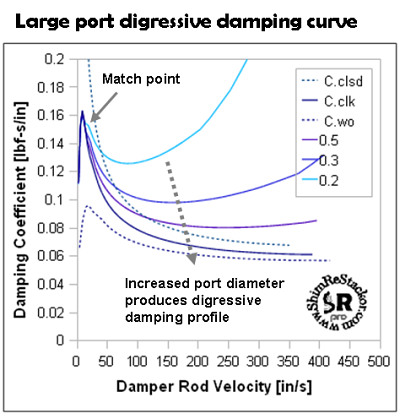 of the damping force curve. Large port diameters allow the valve to
dump flow at low values of shim stack lift. This produces a digressive
damping profile. Small port diameters dominate the damping force curve at
high suspension velocity and result in a progressive damping profile. In between these two extremes a
linear damping profile is produced.
of the damping force curve. Large port diameters allow the valve to
dump flow at low values of shim stack lift. This produces a digressive
damping profile. Small port diameters dominate the damping force curve at
high suspension velocity and result in a progressive damping profile. In between these two extremes a
linear damping profile is produced.
ReStackor computes the change in damping performance produced by port flow area modifications through evaluating the changes in the fluid dynamic forces of jet impingement and jet turning losses caused by the modified port flow area and the shift in the center of pressure acting on the shim stack face . The port area of a stock suspension valve can be modified by drilling the ports to a larger diameter or filling in the ports with JB Weld and re-drilling the ports to a smaller diameter. The increasingly larger valve diameters used in newer suspensions provide more options in tuning the valve port since the port flow area is no longer limited by the diameter of the valve.
Selection of the correct port size for a particular application depends on the shape of the damping force curve desired and the range of suspension velocities the shock will be used over. For the example calculation here the shim stack was retuned at each valve port diameter to maintain the same peak damping force. Increasing the valve port diameter shifts the damping curve towards a digressive profile.
Valve port shape effects on the damping profile
ReStackor is also capable of evaluating the effect of valve port shape on the damping profile produced. Comparison of damping profiles for a round port, perimeter slot and radial rectangular are shown below. The ports for each of these configurations have been set to produce the same flow area. The perimeter slot located at the outer perimeter of the valve allows the flow to dump with little shim stack lift. This produces a digressive damping profile. The radial rectangle port has a lower flow area at the perimeter and requires more shim stack lift to produce the same flow. This shifts the damping profile towards a progressive shape. Through modeling of basic fluid dynamics ReStackor can compute the effect of valve port shape and flow area on your shocks damping profile allowing you to tune the shape of the damping profile and custom tune the damping forces produced by your suspension.
ReStackor can be used to determine the effect of different valve port shapes.
![]()
Digressive damping profile
A digressive damping profiles produce high damping forces at low suspension velocities and reduced damping forces at high speed. Rally cars have made digressive profiles popular due to a need for a suspension soft enough to handle rough sections of the coarse yet stiff enough to give the driver good road feedback at the lower suspension velocities occurring when entering or exiting a turn.
-
Features: Low damping rates at high suspension velocities allow the suspension to float through the rough sections of the coarse partially relieving the strain on the suspension system. High damping rates at low suspension velocities cause the suspension to rapidly settle as soon as the vehicle exits a rough section. More importantly stiff low speed damping gives the driver more road feel and feedback when entering or exiting a turn and provide the stiff low speed damping rates needed to damp the chassis and the reduced high speed damping forces needed to damping the un-sprung mass of the wheels.
-
Drawbacks: The high damping forces at low suspension velocities produce a brutally stiff ride. The suspension remains stiff until bumps are hit hard enough to pound the suspension through the stiff low speed damping range into the softer rates at high speed.
When many riders are confronted with a digressive damping profile they will put in 2.5wt oil and open the clickers to obtain the low speed suspension compliance they want. While this softens the low speed forces produced by a digressive damping profile it also results in a suspension that will suddenly blow through its stoke on larger hits since the shock was designed to produce lower damping at high speed.
If you have a digressive damping curve and are unhappy with the low speed suspension compliance you are better off retuning the shim stack to reduce the digressive behavior. This will provide the low speed compliance that you want while maintaining the high speed damping you need to control the suspension on larger bumps.
Creating a digressive damping profile
Stack preload, high oil viscosities, large valve ports or near closed clicker settings are used to create a digressive damping profile. Each of these parameters can be tuned individually or in combination with ReStackor to create the damping profile you want.
Stack preload, high oil viscosities or near closed clicker settings can be used to create digressive damping profiles.
Stack preload
There are many different options for preloading the stack. Dishing of the valve face, raised lips on the valve edge perimeter, Ohlins X-rings, or a classic Belleville washer can be used to preload the stack. Preloading the stack forces the suspension oil to flow through the clicker bleed circuits until enough pressure is built up to crack the stack open. The point where the stack cracks open forms the start of the digressive damping region.
The most common method for preloading the stack is dishing the valve face. The formula below can be used to trig out the valve face dish radius needed to produce various levels of stack preload.
The ReStackor stack float parameter is used to model stack preload and the valve face dish radius.
ReStackor uses the stack float parameter to model stack preload. Negative values of float preload the stack. Positive values of float lift the stack off of the valve face. Stack preload in ReStackor calculations is applied to the outside edge of the shim stack.
The valve face dish radius needed to produce various levels of stack preload is shown below. A dish radius of 30 inches produces a stack preload of 0.1mm on a 24 mm valve. This 30 inch dish radius is very subtle on the face of a 24 mm valve so some care is needed when trying to measure the 0.004 gap height of a 30 inch dish radius.
Stack preload produced by various values of valve face dish radius.
The shim stack preload used on digressive valve configurations are typically small. These small features can be easily removed by sanding the valve face on a flat surface. Considering that the dish is only 0.004 inch deep it does not take much work to flatten the face. If you decide to remove the digressive behavior of the valve by sanding the valve face you need to be sure you flatten the entire face. Flattening the edge while leaving the center dished results in lifting the edge of the shim stack off of the valve seat, as shown below, and a large reduction in low speed damping.
A thin crossover shim and spacer can be used to adjust the stack preload and alter the digressive behavior of the valve. This can be useful to temporarily test various levels of stack preload before permanently modifying the valve through re-dishing the face.
The shape of the damping force curve produced by a shock absorber is very sensitive to stack preload. A stack preload of one thousands of an inch can produce a substantial change in the shape of the low speed damping force curve.
Small changes in stack preload can produce a substantial change in the low speed damping profile produced in a shock absorber.
To create a digressive damping curve with a flat valve face you can attempt to preload the stack using an Ohlins X-ring or install a classic Belleville washer on the top of the stack. For the Belleville washer case you need to be able to relate the spring stiffness and Belleville washer crush to the preload produced on the stack. For and X-ring or ring shim you can change the thickness of the ring shim, centering shim or the position of the ring shim in the stack to control the stack preload and low speed damping force.
Split ring shims can be used to preload the stack and control low speed damping forces.
In an perfect world the shims used in a shock absorber would be perfectly flat and you could screw the stack clamp too finger tight and the stack would be completely clamped to the shim stack face. In the real world the shims are slightly warped, bent, cupped or pretzeled resulting in some preloading of the shim stack when the clamp nut is tightened. Even a small piece of lint trapped in the stack produces preload on the shim stack.
Bent shims cause preloading of the shim stack when the stack clamp is tightened.
Elimination of stack preload due to bent shims can be very difficult. Bent shims on the order of one tenth of a thousands of an inch (0.0001") is nearly impossible to measure. Yet, in a stack of 30 shims allowing each shim to be bent by 0.0001" produces a stack preload of 0.003" and a substantial change in the low speed damping forces produced by the shock. Bent shims, dirt in the stack and defects in the valve face are some of the unquantified unknowns that cause dyno tuners to state that they cannot setup two shocks to produce the same damping force.
When rebuilding a shock if any of the shims are bent, warped or otherwise damaged they need to be replaced.
![]()
Damping Curve Profile Shapes
A major feature of ReStackor is the capability to plot the shape of the damping force curve produced by your suspension. This gives you the capability to understand the performance of the suspension and retune the shape of the damping force curve to produce the characteristics you want. Classifying the damping curve as linear, progressive or digressive gives you added insight into the expected operational behavior of the suspension and allows you to focus your tuning efforts to perfect the strength and weakness of that damping profile.
While understanding the shape of the damping force profile is useful it can become somewhat irrelevant when tuning your suspension. If the high speed damping of your current setup is too stiff, then it is too stiff and needs to be retuned regardless of the profile shape. Once you have adjusted the suspension and obtained a setup that works well over the entire range of suspension speeds understanding the shape of that retuned profile can be useful in setting up your next bike to duplicate the damping profile you prefer.

